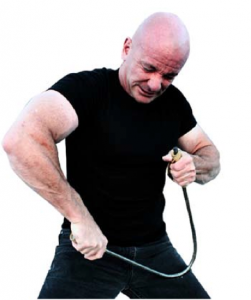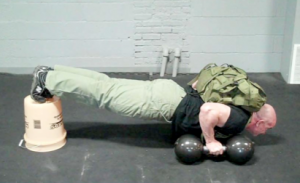I’ve had a chance to look over the Savage Strength Training System from Mike Gillette.
Let me first tell you about the author/creator:

Mike Gillette is a former SWAT commander and Executive Bodyguard. He has enjoyed a career as one of the most highly credentialed tactical trainers in the United States, with over 25 different Use-of-Force and Weapons Systems instructor designations to his name. He is a martial arts practitioner with black belts in Japanese, Filipino and American martial arts styles.
He is also a student of mind/body power who performs impressive feats of strength to prove his methods work. He does this despite being 48 years old with a history of working through various injuries.
Let’s talk about what you get with this program.
Program Components
The Savage Strength Manifesto
This is Mike’s overall philosophy of training, and to a certain extent, life in general.
He explains the principles behind the program. He distinguishes traditional bodybuilding training vs. strength training. Getting big, Mike argues, can be very difficult for some trainees. But virtually anyone can get strong with the correct training techniques. The author uses himself as an example: he is only five foot nine inches tall and 185 lb.
I was really impressed with this e-book. It is a nice combination of motivational and practical information. You’ll see an explanation of the training techniques, but you’ll also find yourself more motivated after reading it.
The Savage Strength Training Logs
This is self-explanatory: printable training logs you can use to track your progress through the workouts.
The Exercise Library
You can see a demonstration of the exercises in two ways. First, you can download a pdf file. But you can also go to a page and watch instructional videos.

Bonus: Video Coaching Walk-Through
You can watch a video walk-through of the training sessions online or you can download them. Technical note: you may find that you have to rename the file and give in an mp4 extension once you have downloaded it. I had to do this but it worked like a charm once I gave the file the correct extension.
Bonus: Construct Your Own Suspension Gym

This one is really cool—you can build your own construction gym with nylon rope and a few other basic, inexpensive items. Gillette shows you exactly how to do this (how to tie the knots—everything).
Bonus: Century Sets
This e-report presents a pretty simple idea: challenge yourself by trying to do one hundred reps of an exercise, like chin-ups.
Review/Recommendation:
Needless to say, I make money off of this blog. But I don’t want to push you into buying something that isn’t for you—I want you to make a decision that will help you reach your fitness goals.
Let me first tell you who/what this program is not for. Savage strength is not a bodybuilding or fat loss program. Yes, you could get bigger or burn fat while training this way, but I’d recommend other programs for those goals. You should always be clear about your goal before you invest in a program (not to mention investing the time to train).
You’ll be doing some weight lifting movements, but you’ll also be doing body weight training and other variations that you wouldn’t find in a traditional bodybuilding program (suspension training, etc).
Savage Strength is about building functional strength. I think it would benefit those who want to get stronger for real-life applications: sports, martial arts, and even everyday activities. I believe this program would be a worthwhile investment if this interest you.
Just CLICK HERE if you want to buy the program or learn more. Please use my links if my review has helped you and don’t hesitate to contact me if you have questions.
Alternative Program:
Mike Gillette also has a program called The Psychology of Strength. This one is designed to help you develop mental toughness.

